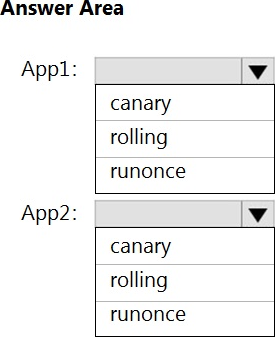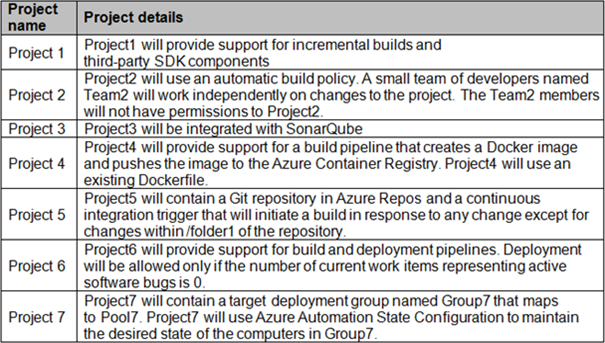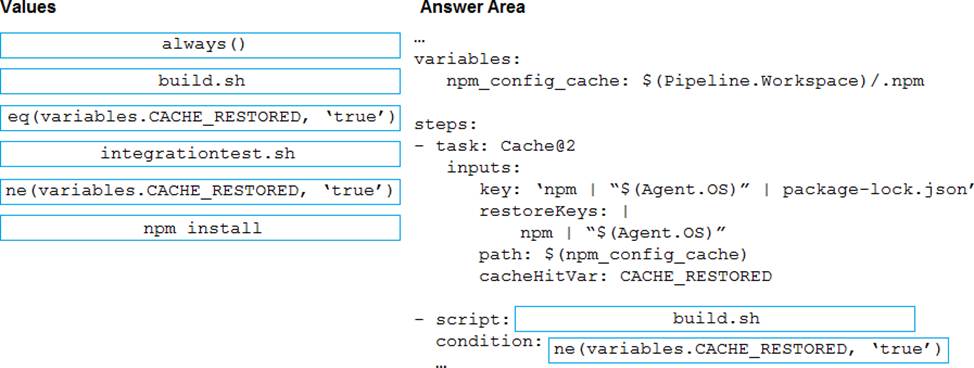Microsoft AZ-400 Übungsprüfungen
Zuletzt aktualisiert am 25.04.2025- Prüfungscode: AZ-400
- Prüfungsname: Designing and Implementing Microsoft DevOps Solutions
- Zertifizierungsanbieter: Microsoft
- Zuletzt aktualisiert am: 25.04.2025
DRAG DROP –
You have a GitHub organization named org1 and an Azure tenant named Tenant1.
You need to enable single sign-on (SSO) in Azure Active Directory (Azure AD) for the users in org1.
Which URIs should you use for the SAML configuration in Azure AD? To answer, drag the appropriate URIs to the correct settings. Each URI may be used once, more than once, or not at all. You may need to drag the split bar between panes or scroll to view content. NOTE: Each correct selection is worth one point.

You have an Azure Resource Manager template that deploys a multi-tier application.
You need to prevent the user who performs the deployment from viewing the account credentials and connection strings used by the application.
What should you use?
- A . Azure Key Vault
- B . a Web.config file
- C . an Appsettings.json file
- D . an Azure Storage table
- E . an Azure Resource Manager parameter file
You have an Azure Resource Manager template that deploys a multi-tier application.
You need to prevent the user who performs the deployment from viewing the account credentials and connection strings used by the application.
What should you use?
- A . Azure Key Vault
- B . a Web.config file
- C . an Appsettings.json file
- D . an Azure Storage table
- E . an Azure Resource Manager parameter file
You have 50 Node.js-based projects that you scan by using WhiteSource. Each project includes Package.json, Package-lock.json, and Npm-shrinkwrap.json les.
You need to minimize the number of libraries reports by WhiteSource to only the libraries that you explicitly reference.
What should you do?
- A . Configure the File System Agent plug-in.
- B . Add a devDependencies section to Package-lock.json.
- C . Configure the Artifactory plug-in.
- D . Delete Package-lock.json.
Your company is building a new solution in Java.
The company currently uses a SonarQube server to analyze the code of .NET solutions.
You need to analyze and monitor the code quality of the Java solution.
Which task types should you add to the build pipeline?
- A . Grunt
- B . Octopus
- C . Maven
- D . Gulp
HOTSPOT
You are designing YAML-based Azure pipelines for the apps shown in the following table.

You need to configure the YAML strategy value for each app. The solution must minimize app downtime.
Which value should you configure for each app? To answer, select the appropriate options in the answer area. NOTE: Each correct selection is worth one point.

DRAG DROP
You have an Azure DevOps pipeline that is used to deploy a Node.js app.
You need to ensure that the dependencies are cached between builds.
How should you configure the deployment YAML? To answer, drag the appropriate values to the correct targets. Each value may be used once, more than once, or not at all. You may need to drag the split bar between panes or scroll to view content. NOTE: Each correct selection is worth one point.

You need to recommend a Docker container build strategy that meets the following requirements:
✑ Minimizes image sizes
✑ Minimizes the security surface area of the final image
What should you include in the recommendation?
- A . multi-stage builds
- B . PowerShell Desired State Configuration (DSC)
- C . Docker Swarm
- D . single-stage builds
Introductory Info
Case Study
This is a case study. Case studies are not timed separately. You can use as much exam time as you would like to complete each case. However, there may be additional case studies and sections on this exam. You must manage your time to ensure that you are able to complete all questions included on this exam in the time provided.
To answer the questions included in a case study, you will need to reference information that is provided in the case study. Case studies might contain exhibits and other resources that provide more information about the scenario that is described in the case study. Each question is independent of the other questions in this case study.
At the end of this case study, a review screen will appear. This screen allows you to review your answers and to make changes before you move to the next section of the exam. After you begin a new section, you cannot return to this section.
To start the case study
To display the first question in this case study, click the Next button. Use the buttons in the left pane to explore the content of the case study before you answer the questions. Clicking these buttons displays information such as business requirements, existing environment, and problem statements. If the case study has an All Information tab, note that the information displayed is identical to the information displayed on the subsequent tabs. When you are ready to answer a question, click the Question button to return to the question.
Overview
Contoso, Ltd. is a manufacturing company that has a main office in Chicago.
Existing Environment
Contoso plans to improve its IT development and operations processes by implementing Azure DevOps principles. Contoso has an Azure
subscription and creates an Azure DevOps organization.
The Azure DevOps organization includes:
The Docker extension
A deployment pool named Pool7 that contains 10 Azure virtual machines that run Windows Server 2019 The Azure subscription contains an Azure Automation account.
Requirements
Planned changes
Contoso plans to create projects in Azure DevOps as shown in the following table.

Technical requirements
Contoso identifies the following technical requirements:
Implement build agents for Project1.
Whenever possible, use Azure resources.
Avoid using deprecated technologies.
Implement a code ow strategy for Project2 that will:
– Enable Team2 to submit pull requests for Project2.
– Enable Team2 to work independently on changes to a copy of Project2.
– Ensure that any intermediary changes performed by Team2 on a copy of Project2 will be subject to the same restrictions as the ones defined in the build policy of Project2.
Whenever possible, implement automation and minimize administrative effort. Implement Project3, Project5, Project6, and Project7 based on the planned changes.
Implement Project4 and configure the project to push Docker images to Azure Container Registry.
In Azure DevOps, you create Project3.
You need to meet the requirements of the project.
What should you do first?
- A . From Azure DevOps, modify the build definition.
- B . From SonarQube, obtain an authentication token.
- C . From Azure DevOps, create a service endpoint.
- D . From SonarQube, create a project.
Introductory Info
Case Study
This is a case study. Case studies are not timed separately. You can use as much exam time as you would like to complete each case. However, there may be additional case studies and sections on this exam. You must manage your time to ensure that you are able to complete all questions included on this exam in the time provided.
To answer the questions included in a case study, you will need to reference information that is provided in the case study. Case studies might contain exhibits and other resources that provide more information about the scenario that is described in the case study. Each question is independent of the other questions in this case study.
At the end of this case study, a review screen will appear. This screen allows you to review your answers and to make changes before you move to the next section of the exam. After you begin a new section, you cannot return to this section.
To start the case study
To display the first question in this case study, click the Next button. Use the buttons in the left pane to explore the content of the case study before you answer the questions. Clicking these buttons displays information such as business requirements, existing environment, and problem statements. If the case study has an All Information tab, note that the information displayed is identical to the information displayed on the subsequent tabs. When you are ready to answer a question, click the Question button to return to the question.
Overview
Contoso, Ltd. is a manufacturing company that has a main office in Chicago.
Existing Environment
Contoso plans to improve its IT development and operations processes by implementing Azure DevOps principles. Contoso has an Azure
subscription and creates an Azure DevOps organization.
The Azure DevOps organization includes:
The Docker extension
A deployment pool named Pool7 that contains 10 Azure virtual machines that run Windows Server 2019 The Azure subscription contains an Azure Automation account.
Requirements
Planned changes
Contoso plans to create projects in Azure DevOps as shown in the following table.

Technical requirements
Contoso identifies the following technical requirements:
Implement build agents for Project1.
Whenever possible, use Azure resources.
Avoid using deprecated technologies.
Implement a code ow strategy for Project2 that will:
– Enable Team2 to submit pull requests for Project2.
– Enable Team2 to work independently on changes to a copy of Project2.
– Ensure that any intermediary changes performed by Team2 on a copy of Project2 will be subject to the same restrictions as the ones defined in the build policy of Project2.
Whenever possible, implement automation and minimize administrative effort. Implement Project3, Project5, Project6, and Project7 based on the planned changes.
Implement Project4 and configure the project to push Docker images to Azure Container Registry.
In Azure DevOps, you create Project3.
You need to meet the requirements of the project.
What should you do first?
- A . From Azure DevOps, modify the build definition.
- B . From SonarQube, obtain an authentication token.
- C . From Azure DevOps, create a service endpoint.
- D . From SonarQube, create a project.



